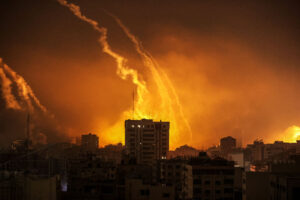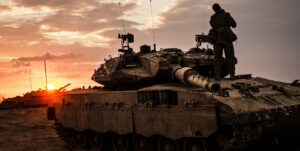Southern Israel is a region at war. Driving down from Tel Aviv to the border towns on the frontlines of the war with Hamas, I pass a truck with an open back carrying a load of heavily armed soldiers cradling automatic rifles in their laps. One looks up at me, sees that I’m press, extends two fingers, cocks his thumb, and shoots.
I pass through Sderot. At its closest point, it is 840 metres from Gaza; it has suffered rocket attacks from Hamas for years. Sderot tells its own story of Israel. Founded in 1951 as a transit camp for refugees, it was built on the site of the Palestinian village of Najd that Israel seized in 1948. It became a hub for Moroccan Jews, those considered almost on the lowest rung of the Jews from Arab lands who were dumped in less desirable parts of the country — often onto border settlements designed to defend against possible infiltration. Then came the Jews from the USSR and then from Ethiopia.
Like so many border towns, Sderot is a mixture of gloom and kitsch. On the way down, I pass a bollard with three poodles painted on it. The city sign is bisected by green: a reference to the Zionist dream of “making the desert bloom”. Inside, the streets are largely empty, and surrounded by dirty beige and white squat, concrete houses. Israeli flags line central street verges. A few run-down children’s playgrounds are scattered around the centre. They would be depressing at the best of times — now that the city has been largely emptied by rocket fire, they are eerie. Hamas appears to be firing rockets every hour. Their thuds echo through the almost deserted streets. This may well be the most attacked city in Israeli history.
On the outskirts of Sderot, I climb Kobe’s hill, which looks out over Gaza. Three disks of blazing gold burst up. Hamas is firing rockets at Israeli cities. A thick plume of smoke rises from the Strip and unfurls across the sky. Israel’s ground troops are fanning out below; the Air Force is pounding from the skies.
I head out to Ashkelon, another border town that has also experienced sustained Hamas attacks; the sound of jets overhead is ferocious. A kippah-wearing soldier waves us through the checkpoint into the city. Again, the streets are largely deserted. On the pavement by the sea, rows of empty chairs stand forlornly outside shuttered cafes. Cafe Seaview is open, however. Three men, one wearing a kippah, and a woman in an olive-green jumpsuit are sitting outside drinking black coffee and smoking. The man in the kippah is called Gabay and he tells me that the situation today is far worse than the 1973 Yom Kippur war. “Then they attacked our armies. But Hamas are the new Nazis. They target civilians,” he says.
His friend interjects. “We haven’t been aggressive enough. We shouldn’t wait for something to happen to be aggressive. We should be aggressive all the time — like we used to be 30, 40 years ago.” The people around the table blame the internal divisions in the country that followed Netanyahu’s attempted reform of the judiciary for the lapse in security that allowed thousands of Hamas terrorists to stream across the border and massacre over 1,400 Israelis on 7 October. Specifically, they blame “Leftists” for all this, not the man in overall charge. This is Netanyahu country; working class Mizrahim are his people.
“In 1948, the Palestinians were offered a homeland, but they refused and tried to throw us into the sea. [Former Israeli Prime Minister] Golda Meir was right when she said, ‘if we lay down our weapons there will be no Israel. If they lay down their weapons, there will be peace.” The atrocities took place just kilometres from where we sit, and I ask how they can live under such constant threat. Their answer is unanimous. We were born here. Our families are here. We don’t care about the rockets. We are ragu’a! ragu’a! [calm].”
One of them starts singing the Hatikvah, the Israeli national anthem. The group links arms and joins in with the first verse. After they finish, Gabay yells “Yallah, Beitar!” Beitar Jerusalem is an Israeli football club associated with Right-wing Zionism and the Likud Party; its fanbase is notorious for its anti-Arab songs. The irony is that, as I look at these Moroccan Jews, drinking coffee and chain smoking, it could be a scene from any of the innumerable Arab countries I have visited across the region.
Back in central Ashkelon, the air raid siren sounds; explosions cut through the air. After taking shelter, I meet Tony. He works at the power plant in the city, a vital job that means he cannot leave. He was at home with his wife and three children when a rocket struck last week. “I heard the siren and ran to the shelter with my family. You get used to the sound of the rockets. Boom, boom, boom. And that’s it. But this time it was bada boom! We knew it was bad.” The rocket destroyed about five cars as well as uprooting a pillar on the pavement outside and smashing the front of the building. But they work fast here and most of the damage was repaired.
In Shemesh’s cafe I meet Alon and Lior. “We need to eliminate every Hamas supporter,” Lior tells me. “I’m angry because we can’t live by their side because they want to kill us. Is it legitimate to kill children? To do what they did to their parents? What organisation in the world is like Hamas, if not Isis? We shouldn’t negotiate with them because they don’t want us here. Can you negotiate with a wall?” What about the hostages? “The hostages will not come back,” he replies.
Alon interjects. “Look, we need to separate Hamas supporters and regular Gazans — not every civilian in Gaza supports them,” he says. “What choice do many of them have? The media talks about how we want to kill all the civilians in Gaza, but it’s not true. We are talking about just Hamas.”
“I had a worker from Gaza in my construction business,” he continues. “He couldn’t come to work for five months but I still sent him money regularly.” This is something I have noticed here in Israel and in the Palestinian territories. When normal people from both sides encounter each other in everyday life, they generally get along, at least superficially. Humanising a conflict, giving a face to your enemy, almost inevitably means that much of the political and ideological noise fades away. But this is a conflict driven by extremes on both sides, and swathes of them have no interest in coexistence.
Soon, fire erupts once more in the skies. This time, though, it is on a different scale: this is the largest rocket attack yet and I am caught in the open. An orange ball streaks across the sky. It is the Iron Dome. I see it strike and the Hamas rocket explode, its threat extinguished. A few minutes later, word comes through that one of the rockets has hit home. Several streets away, I arrive at the scene. A phalanx of white-shirted Orthodox Jews scampers past me to look. Medics thread their way through the crowds. Emergency servicemen carry rifles. I look down a road and see detritus in the street, but we cannot get any closer. A man looks at my press jacket and bearded dark features. “What channel are you from? He calls out laughing, “Al Jazeera?!”
I drive down Menachem Begin Boulevard. On the radio Netanyahu is saying that the country is in a second war for its independence. Israel is a country self-consciously fashioned from history, and it cannot escape history as a result; it was born from trauma and cannot escape it. When I visit Palestinian towns and cities, I hear the same thing: endless references to the 1948 war, which they call the Nakba (catastrophe) and the 1967 Six-Day War, which they call the Naksah (setback).
As the week ended, the IDF announced that its troops had broken through its enemy’s defensive lines and killed dozens of Hamas fighters. Hamas was reporting yet more civilian deaths and boasting that it had killed yet more Israeli soldiers. It made me think back to something Gabay told me in Ashkelon when I asked him what the solution to all this was. “Solution?” he replied. “Believe me, if there was a solution, we would have found it already.”
Disclaimer
Some of the posts we share are controversial and we do not necessarily agree with them in the whole extend. Sometimes we agree with the content or part of it but we do not agree with the narration or language. Nevertheless we find them somehow interesting, valuable and/or informative or we share them, because we strongly believe in freedom of speech, free press and journalism. We strongly encourage you to have a critical approach to all the content, do your own research and analysis to build your own opinion.
We would be glad to have your feedback.
Source: UnHerd Read the original article here: https://unherd.com/



